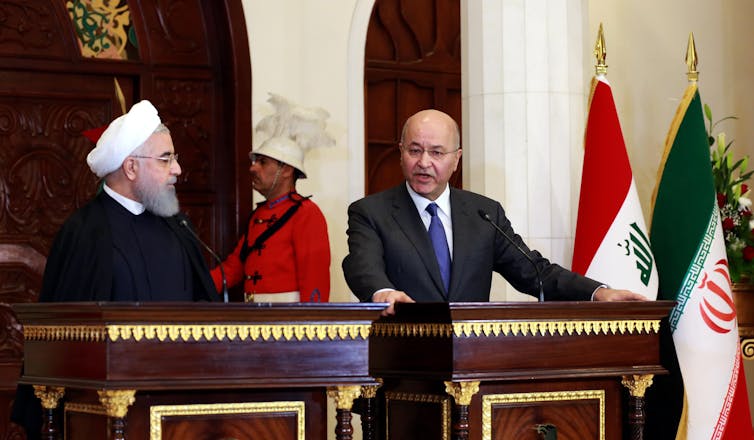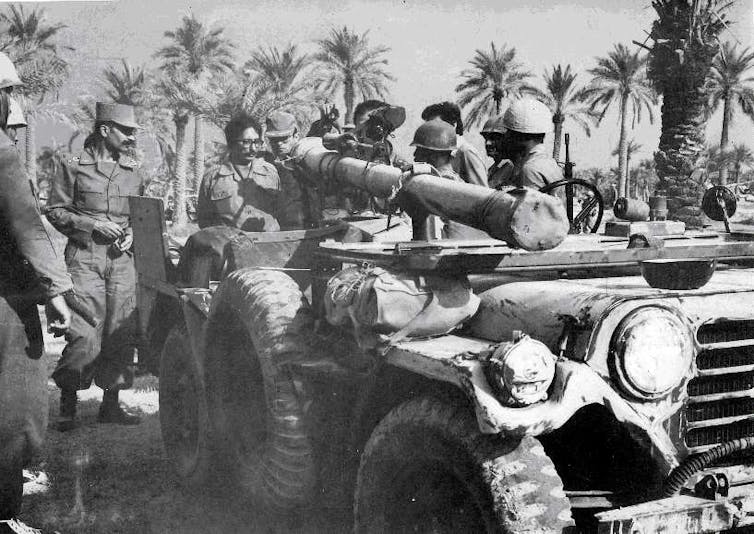Following his capture by American troops, Saddam Hussein made a startling admission to George Piro, the FBI investigator tasked with interrogating him. The reason he had played cat and mouse with UN weapons inspectors for over a decade was not because he was trying to hide Iraqi production of weapons of mass destruction from the west.
Rather, the decision to embark on such a perilous course – one that had ultimately led to Hussein sitting ignominiously in front of his FBI interrogator in a US base at Baghdad Airport – was taken to conceal from Iran that Iraq had lost much of its weapons capabilities.
Iraq’s fear of Iran vastly overshadowed its fear of the US. Iran’s weapons capabilities, Hussein told Piro in 2004, had increased dramatically while Iraq’s had been largely eliminated due to UN sanctions. The effects of this, he concluded, would be felt acutely in the future.
At a time when the US seems to be engaging Iran in a proxy war on Iraqi soil, Hussein’s warning appears almost prophetic. But as my own ongoing research on the recent history of Iraq and its relationship with Iran is showing, the tensions between the two countries have long dominated the decision making of their leaders.
Read more:
What next for Iran’s proxy network after killing of Qassem Soleimani
War by proxy
Successive military coups in Iraq led to the takeover by the Ba’ath Party in 1968 and Hussein’s gradual ascent to power through the 1970s. During this period, both Iran and Iraq actively used proxies to undermine each other. As I also explore in a forthcoming book on Iraq’s history, Iran supported an ongoing Kurdish rebellion in Iraq, with secret assistance by the CIA and Israel. Meanwhile, Iraq sponsored various secessionist movements in Iran’s “Arabistan” province, called Khuzestan.
In March 1975, Hussein agreed to a humiliating redrawing of the borders between the two countries along the Thalweg of the Shatt al-Arab river in exchange for cessation of Iranian logistic support for the Kurdish rebels. Iran’s Shah sold out his proxies and Hussein brutally finished the Kurdish rebellion.
Yet, tensions between the two countries continued. Helped by unprecedented oil revenues following the nationalisation of Iraq’s oil industry in 1972, Hussein constructed a fierce war machine – intent on redressing his earlier concession to the Shah.
Iraq invades Iran
When Iran erupted in Islamic Revolution in 1978-9, Hussein saw his opportunity. In September 1980, amid Iranian turmoil, Iraq invaded the country. Far from the rapid victory Hussein had envisaged, however, the war dragged on for eight long years, killing and injuring more than a million people and devastating both countries materially.
Via Wikimedia Commons
Through the war and its aftermath, Iran cultivated links with Iraq’s domestic Shia opposition – the Da’wah Party. Before the war, Iraq had executed Muhammad Baqer al-Sadr, the spiritual leader of the party, and father-in-law of Muqtada al-Sadr, the influential Shia cleric. Much of the organised Shia opposition was suppressed, and many of its leaders eventually sought refuge in Iran, where in 1982 the Supreme Council for the Islamic Revolution in Iraq (SCIRI) was set up as a Shia political party.
Iraq’s failed invasion of Kuwait and defeat by the international coalition in early 1991 triggered domestic uprisings by the Shia in the south and the Kurds in the north. These were defeated, but sanctions and UN inspections throughout the 1990s meant that Hussein’s regime effectively ceded autonomy to the Kurds in northern Iraq. Meanwhile, Iran continued to sponsor both the Iraqi Kurds and Shia.
After the 2003 invasion
The 2003 war ended Hussein’s regime, and, as he had predicted, saw Iran’s influence in Iraq and the wider region grow exponentially. Although CIA analyses throughout the 1990s had consistently warned that this was a likely scenario upon the removal of the regime, the George W Bush administration decided to enact “regime change” regardless and with little planning for what would come after.
The outcome, as predicted, was that Iran filled the new Iraq with its proxies. Soon after the fall of the regime, exiled Da’wah and SCIRI leaders made their way back to Iraq. Together they have dominated every election since the invasion, creating in effect an “elected dictatorship” where, for demographic and sectarian reasons, no other bloc or group has any realistic chance of winning an election.
Read more:
Iraq’s discontent – its roots and how to begin fixing it
For several years, though, an uneasy Iraqi truce seemed to exist between Iran and the US, where both countries assessed the new lay of the land while effectively backing the same Shia and Kurdish leaders. This was particularly evident during the premiership of Nuri al-Maliki between 2006 and 2014, who retained the support of both the US and Iran.
When Maliki stepped down in 2014 in favour of his Da’wah comrade Haidar al-Abadi, Islamic State (IS) was threatening the very existence of the Iraqi state. The uneasy truce between the Americans and Iranians was upheld to fight this insurgent threat.
Iraq’s army and government institutions were too weak and soon so-called Popular Mobilisation Units (PMU), also known as Hashd al-Shaabi, were formed to fight IS. Consisting of a wide array of ideological and sectarian militias – many of whom are Shia and attached to specific political groupings, the PMU were an integral part of the defeat of IS and have continued to play important roles as many have refused to disarm.

Ahmed Jalil/EPA
During the fight against IS, US troops were again stationed in Iraq and neighbouring Syria. Iranian troops and proxies, coordinated by the commander of its Quds Force, Major-General Qassem Soleimani – who was assassinated by the US in early January 2020 – were also integral to the defeat of the jihadists.
Read more:
What next for Iran’s proxy network after killing of Qassem Soleimani
It was during these last few years of uncertainty that the inevitable clash of US and Iranian interests in Iraq became particularly visible. A situation where Iraq’s political leaders are ideologically affiliated with Iran while the US has sought to shape Iraq in its own image with free elections and a liberal political system, plus economic ties with western energy firms, was bound to cause friction eventually.
Whatever happens next, one thing is certain. Iraq is the big loser in an Iranian-American proxy war played out on Iraqi soil, and the Iraqi people continue to suffer.
Credit: Source link




